
At the National Museum of the Republic of Kazakstan held the opening ceremony of the exhibition "Milestones of the theater history" of the museum of the Kazak State Academic Drama Theater named after Mukhtar Auezov.

The exhibition was organized by the Ministry of Culture and Sports of the Republic of Kazakstan, by the National Museum of the Republic of Kazakstan and the by Kazak State Academic Drama Theatre named after Mukhtar Auezov, and timed to coincide with 90th anniversary of the Theatre and the 25th anniversary of Returning Independence.

We are offering to YOUR attention, dear reader, to plunge into a short excursion along the history of the milestones of the Kazak State Academic Drama Theatre named after Mukhtar Auezov. Well, First of all, Kazak State Academic Drama Theatre named after Mukhtar Auezov was found in 1925 in Ak-Meshit ( Kyzyl-Orda) which was at that time the second capital (moved from Orynbor-Orenburg which was first capital of Kazakstan in Soviet period, later was taken of from Kazakstan after moving capital and also during colonisation politic against Kazakstan 1918 to 1925 together with many other cities(also even before and after, we will talk about it next time). Later in 1926, 13 January the theater opened by play piece "Altyn Sakina" ("Golden Ring") of Koshke Kemengerov directed by Seraly Kozhamkulov with a big concert. In the early years of the organization of theater plays staged succession of national drama, drawing life of old aul- "Wives-rival" and "Karakoz" of Auezov, "Golden Ring" Kemengerov, "Malkambay" of Erdanaev (all 1926) -or the formation of the Soviet authorities - "Red Falcons" of Seifullin (1926), "Zarly" of Uspanov and Uteulin (1927)," Perizat and Ramazan "of Tlepbergenov (1928). 1928 theatre moved to the new capital of republic Almaty( became capital in 1927). A great place in the repertoire of the play took historical and folklore content, has been regularly renewed, "Enlik and Kebek" of Auezov (1926, 1933, 1957), "Arkalyk Batyr 'of Shanin (1926, 1935). Along with the performances the theater gave concerts, folk evenings arranged creativity. Also in 1926 were staging "Enlik and Kebek" of Mukhtar Auezov, "Altyn Sakina" ("Golden Ring") of Koshke Kemengerov (directed by Kozhamkulov), "Baybishe - Tokal" ("Wives-rival") of Mukhtar Auezov, "Balkiya" of Mirjakyp Dulatov, "Careerists" of Jussupbek Aimautov, "Equality rights of women" of Serkebayev, "Sher-Niyaz" of Jussupbek Aimautov, "Isatai Batyr" of Basimov, "Karakoz" of Mukhtar Auezov (directed byDzhandarbekov), "Tricky Mullah" of Beimbet Maylin (directed by Koshke Kozhamkulov), "People's School" of Beimbet Maylin, "Fur hat" of Uspanov (directed by Koshke Kozhamkulov), "Malkambay" of Erdanaev (directed by Umurzakov), "Torsykbay" of Shanin (directed by Shanin), "Wedding" of Beimbet Maylin, "Girl-coquette" of Jussupbek Aimautov, "Uyshik-Uyshik" of Mendyhanov. "Getting rid of the sores" of Anov "Kyzyl sunkarlar" ("Red Falcons") of Saken Seifullin (directed by Shanin). In 1927 the most popular performances were "Arkalyk Batyr 'of Shanin directed by himself (directed by himself J. directed by Shanin)," The Stone Guest "," The Miserly Knight "of Alexander Pushkin", Hamlet " of William Shakespeare (directed by Shanin)," Zarlyk "of Uspanov and Uteulin (directed by Kozhamkulov)," Tricky Aidarbek" of Shanin directed by himself, "Old School" of Koshke Kemengerov, "Not jealous wives" of Ablanov, "Rabiga" of Jussupbek Aimautov, "1916 year" of Albanov, "Yellow hill" of Zabaev, "The two laws" of Tokmagambetov, "Turban" of Beimbet Maylin".

In 1928 most visited performances were "Lovers", "Perizat and Ramazan" of Tlepbergenov, "Canapiya-Sharbanu" of Jussupbek Aimautov, "The mullahs bribe-takers," of Baiguzhaev, "Nadir Khan" of Narimanov. "Recluse" of Malabaelz, "Marriage" of Gogol (directed by Kozhamkulov and Dzhandarbekov), "Takers" of Koshke Kemengerov, "From death to the hope" directed by himself J. Shanin, "Karakalpak girl" of Ermanov, "Bayan-batyr" directed by himself J. Shanin. In 1929 most liked performances were (After moving to Alma-Ata) "Points" of Beimbet Maylin. "Zaure" of Bayseitov and Shanin (directed by Baiseitov), "Marriage" (directed by Sokolov). In 1930, the most discussed performances were "Bloody stick" of Kamalov and Tair Zharokov, "Bolat" A. Shanin (directed by J. Shanin) "The verdict" of Levitina (directed by Sokolov), "Mine" of J. Shanin (directed by Dzhandarbekov, art director Stolyarov), "Agony" of Temirbekov (directed by himself J. Shanin ), "Fighting" of Bayseitov and A. Shanin (directed by Baiseitov), "Loitering" of Beimbet Maylin. In 1931, the most adored by the public performances were "In the day of judgment" (directed by Jumat Shanin), "Black Heart" of Iliyas Jansugurov (directed by Zhumat Shanin), "Bloody torture" of Baiseitov (directed by Beisov), "Rebellion" of Dmitri Furmanov, "Revenge" of Iliyas Dzhansugurov, "Front" of Beimbet Maylin (directed by Zhumat Shanin, art director Stolyarov), "the Far East", "Yellow devil" (directed by Kurmanbek Dzhandarbekov).
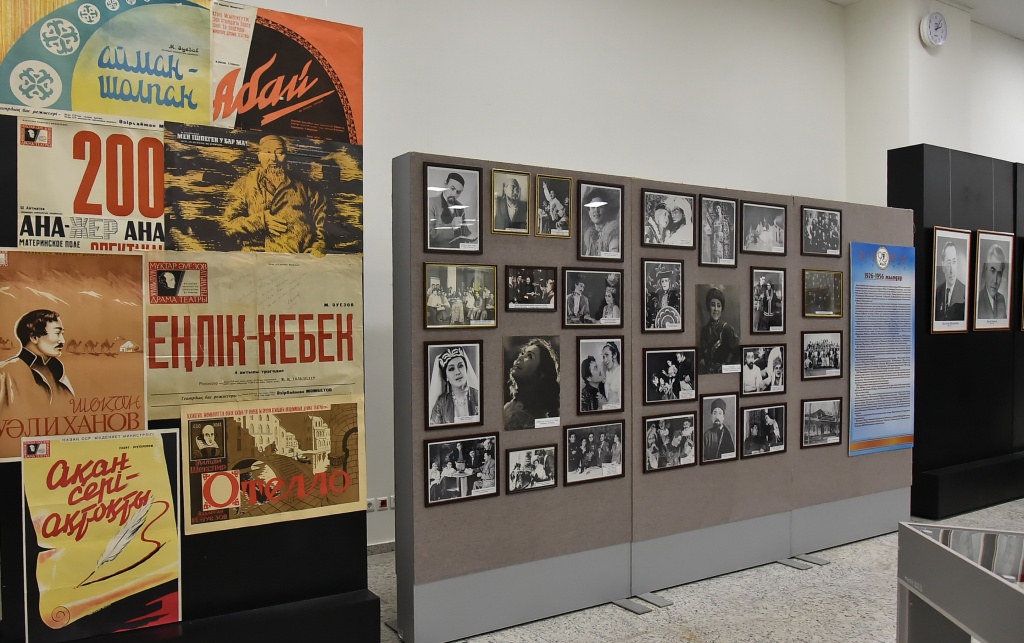
1932 remembered by such brilliant play-pieces "The glow" of Gaydovsky (directed by Baiseitov), "Teacher madrassas" of Beimbet Maylin (directed Seraly "Serke" Kozhamkulov), "Homeless" of Shanin (directed by Kalibek Kuanyshpaev), "Turksib" of Iliyas Dzhansugurov, "Submarine" of Trigger (Taneyev, art director Stolyarov), "For October" Mukhtar Auezov (directed by Zhumat Shanin). The performances of the theater differed ethnography, precision in the transmission of national life. During the First Five-Year Plan in the repertoire of the play appeared on the themes of industrialization - "Mine" of Shanin (1930), "Turksib" of Dzhansugurov (1932), on the collectivization - "Revenge" of Dzhansugurov, "Front" of Maylin (both 1931). In 1932-1938 Mukhtar Auezov was head of literary department. In 1933 -34, music studio separated from the theater. In 1936, theatre participated in the ten-day of Kazak literature and art in Moscow. 1933 - 1937 remembered to the public of theater by such brilliant play-piece stages as "Bread" of Kirshon (directed by Nasonov, art director Zverev), "My friend" of Pogodin (directed by Nasonov, art director Ulanovskii), "Mstislav the Bold" of Prut (directed by Nasonov, art director Khodzhikov), "Enlik and Kebek" of Mukhtar Auezov. 1934. "The document" of Rahmankulov (directed by Baiseitov), "Khan Kone" of Mukhtar Auezov (directed by Nasonov, Bekov), "Taltanbay" of Beimbet Maylin (directed by Nasonov, art director Khodzhikov).
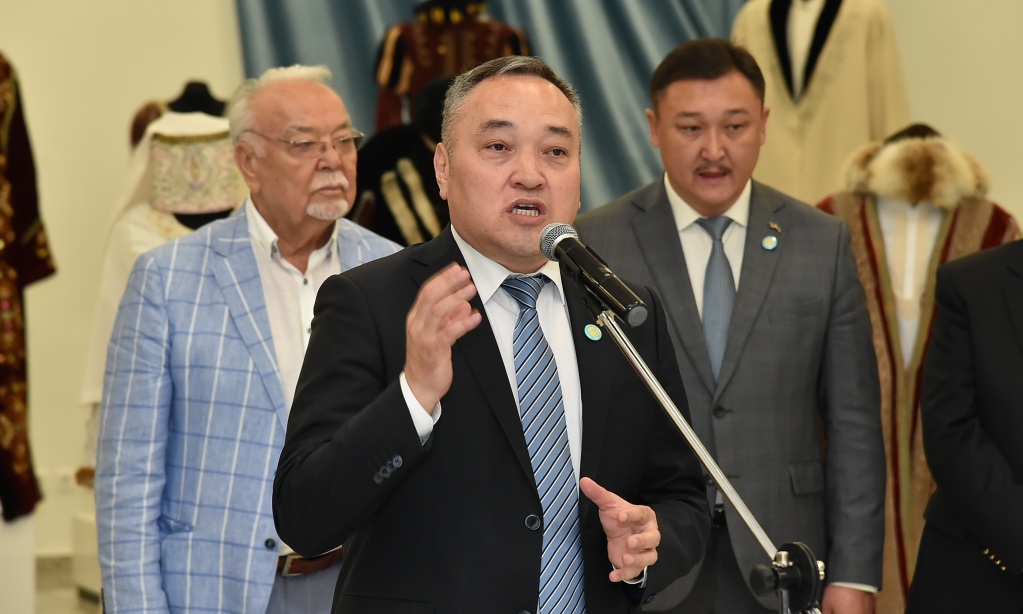
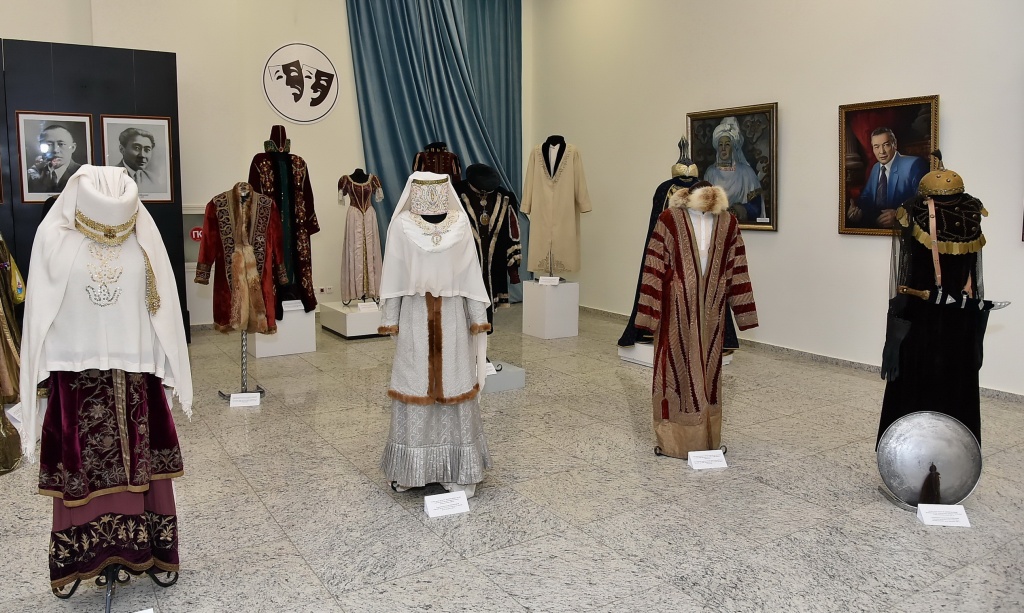
1935. "Night rumblings" of Mukhtar Auezov (directed by Rutkowski, art director Kantor), "Arkalyk Batyr "of Shanin (directed by Nasonov, Umurzakov, art director Kantor)," Our Dzhigits "of Beimbet Maylin (directed by Kalabukhov)," Two Girls "of Baiseitov (directed by Nasonov)," Stone plumage "of Mukhtar Auezov (directed by Nasonov, art director Nenashev). 1936. "The Aristocrats" of Pogodin (translation of Mukhtar Auezov, directed by Borov, art director Ufimtsev), "Inspector General" (translation of Mukhtar Auezov, dir. Borov, art director Zavarzin), "Red Falcons" of Saken Seifullin (directed by Nasonov, art director Kondoidi). 1937. "Amangeldy" of Gabit Musrepov (directed by Borov), "In an apple orchard" of Mukhtar Auezov (directed by Borov, art director Charnomsky), "Spring Love" (directed by Nasonov). In 1937 to the theatre has been appropriated the status of "Academic". 1937-1946 was remembered to public of the theater by 1938. "Azret Sultan" of Tokmagambetov (directed by Nasonov), "On the border" of Mukhtar Auezov (directed by Nasonov), "Tricks of Rock" (directed by Holodnaya), "Isatai and Makhambet" of Ahinzhanov (directed by Ismailov). 1939. "In the days of struggle" of Sabit Mukanov (directed by Nasonov), "Othello" (translation of Mukhtar Auezov, dir. Sokolovsky, art director Khodzhikov, Uskembaev), "White Birch" of Abdilda Tazhibaev and of Mukhtar Auezov (directed by Nasonov).
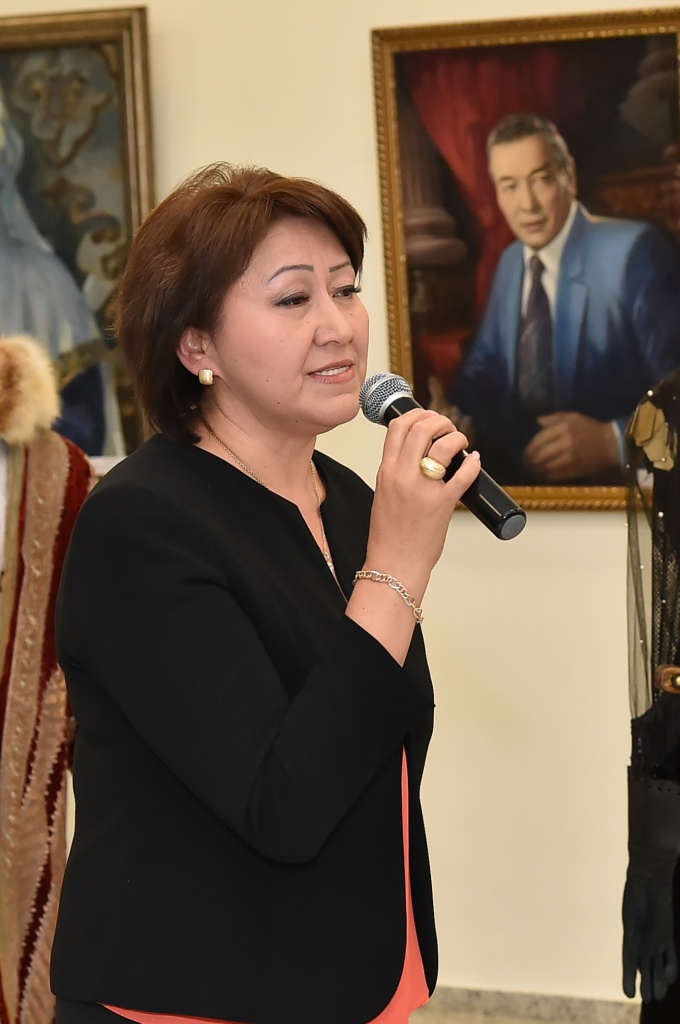
1940. "Not all to a cat Mardi Gras" of Ostrovsky (directed by Nasonov), "Man with a Gun" (directed by Sokolowski, art director Silaev), "Inspector General" (resumed by. Sokolowski), "Kozy-Korpesh and Bayan Sulu" of Gabit Musrepov (directed by Nasonov, art director Mikheev) "For the Motherland" of Abishev (directed by Nasonov), "Abay" of Mukhtar Auezov and Sobolev (directed by Tokpanov, art director Charnomsky, Khodzhikov). 1941. "Eugenie Grandet" of Balzac (directed by Beysekov), "Marabay" of Khusainov (directed by Tokpanov, art director Khodzhikov), "Comrades" of Abishev (directed by Badyrov), "Professor Mamlok" of Wolf (directed by Goldblatt), "In the hour of trial" of Mukhtar Auezov / directed by Tokpanov). 1942. "Akhan-sere and Aktokty" of Gabit Musrepov (directed by Goldblatt, art director Charnomsky), "Victory song" of Sabit Mukanov (directed by Tokpanov, art director Raspopov), "Guard of Honour" of Mukhtar Auezov and Abishev (directed by Goldblatt, art director Charnomsky), "Vigilance "of Abishev (directed by Ismailov, art director Raspopov)," Aldar-Kose "of Khusainov (directed by Goldblatt, art director Charnomsky). 1943. "Peter Krymov" of Finn (directed by Margolin), "Kozy-Korpesh and Bayan Sulu" of Gabit Musrepov (directed by Ismailov), "The Taming of the Shrew" (translation of Mukhtar Auezov, dir. Pyzhova, Bibikov, art director Charnomsky). 1944. "Enlik and Kebek" of Mukhtar Auezov (directed by Tokpanov). 1945. "Amangeldy" of Khusainov (directed by Shaken Aimanov), "Naked Sword" of Mukhtar Auezov and Gabit Musrepov (directed by Ridal), "Carpet of Zhomart" of Abdilda Tazhibaev. 1946. "The Government Inspector" (directed by Rutkowski), "Koblandy" of Mukhtar Auezov (directed by Badyrov, Stein), "The Lower Depths" (directed by Ridal, art director Balhozin). In 1946, in honour of the 20 th - anniversary of the theater awarded the Order "Red Banner of Labour". 1947-1960 year was memorable to public of the theater 1947. "Winners" of Chirskov (directed by Tovstonogov, art director Charnomsky), "Friendship and love" of Abishev (directed by Shaken Aimanov), "Mistress of the Inn" (directed by Ismailov), "Man with a Gun" (directed by Shaken Aimanov, Rutkowski). 1948. "The deep roots" of Gough and D'Yusso (directed by Tokpanov, art director Golubovic), "Duel" Zhumaliev and Sarsembayev (directed by Shaken Aimanov), "Wits" of Khusainov, Kuanyshpaev (directed by Shaken Aimanov, art director Khodzhikov), "Act of Honor" Stein.

1949. "Talents and Admirers" (directed by Shaken Aimanov), "Gems" of Baimukhamedov (directed by Shaken Aimanov), "One Family" of Abishev (directed by Dyakov), "Abay" of Shaken Aimanov and Stein (directed by Stein, art director Golubovic). 1950. "Thunderstorm" (directed by Markov, art director Golubovic), "Millionaire" of Gabiden Mustafin (directed by Tokpanov), "Voice of America" of Lavrenev (directed by Shaken Aimanov). 1951. "The delegate Daniyar" of Baizhanov (directed by Stein), "Snowball Grove" of Korniychuk (directed by Shaken Aimanov). 1952. "Amangeldy" of Gabit Musrepov (directed by Goldblatt, art director Golubovic), "The Miser" (directed by Goldblatt, art director Park), "Be green, the steppe!" of Abdilda TazhiBaev (directed by Goldblatt). 1953. "Kozy-Korpesh and Bayan Sulu" of Gabit Musrepov (directed by Goldblatt, art director Nenashev), "Silk Suzane" of Kahhar (directed by Estemesova), "My Love" of Imanzhanov (directed by Estemesova). 1954. "Love at dawn" of Galan (directed by Goldblatt), "Dubai Shubaevich" of Abdilda Tazhibaev (directed by Stein, directed by Badyrov). 1955. "Farhad and Shirin" of Hikmet (directed by Goldblatt), "The truth is-well, but happiness is better" of Ostrovsky (translation of Abdilda Tazhibaev, dir. directed by Estemesova, Diordiev), "Envy" of Abishev (directed by Goldblatt, art director Golubovic), "Yesterday and today "of Khusainov (Ibragimov, art director Balhozin).

1956. "Shokan Valikhanov" of Sabit Mukanov (directed by Goldblatt, art director Golubovic), "Sick teeth" of Kahhar (directed by Ibragimov). 1957. "Enlik and Kebek" of Mukhtar Auezov (directed by Goldblatt), "Maira" of Abdilda Tazhibaev (directed by Tokpanov), "Who is my father?" of Abishev (directed by Oguzbaev), "On the bank of the Irtysh" of Khusainov. 1958. "The Taming of the Shrew" (resumed by. Pyzhova and Bibikov), "The tragedy of the poet" of Gabit Musrepov (directed by Shaken Aimanov, art director Golubovic), "One tree is not a forest-" of Abdilda Tazhibaev (directed by Goldblatt, Mambetov, art director Erzhanov). 1959. "The cub under the heading" of Mukhamedzhanov (directed by Azirbaijan Mambetov, art director Erzhanov), "The Prodigal Son" of Rannette (directed by Azirbaijan Mambetov), "What would you do?" of Gabit Musrepov (directed by Azirbaijan Mambetov). 1960. "Familiar People" of Khusainov, "Ayman and Sholpan" of Mukhtar Auezov (directed by Azirbaijan Mambetov, art director Nenashev), "Oh, girls!" of Baisetov and Shangatbaev (directed by Azirbaijan Mambetov), "Thus began the era" of Shashkin (directed by Azirbaijan Mambetov, art director Charnomsky). In 10 th august 1961 by the decission of the Council of Ministers of the KazSSR to the Kazak State Academic Drama Theatre given the name of the great world and word artist Mukhtar Auezov. Since the beginning of the 60s began a period of revival of national directing. It should be noted the name of the eminent theatre director, figure of arts, People's hero Azirbaijan Mambetov. 1961. "Marriage" (of Zhanturin, art director Charnomsky), "Matchmaker came" of Kayum Mukhamedzhanov (directed by Azirbaijan Mambetov), "Saule" of Akhtanov (directed by Dzhandarbekov and Madievsky), "The Dreamers" of Abishev (directed by Azirbaijan Mambetov).1962. "The fourth" of Simonov (directed by Madievsky). At the origin of the theater were masters of folk art and amateur A. Kashaubaev, K. Dzhandarbekov, Kozhamkulov S., K. Kuanyshpaev, E. Umurzakov, I. Baizakov, K.Beisov, K. Badyrov, Munaitpasov K., J. Shanin , F. Ashkeeva, Z. Atabaeva, S. Baizakov, Shamova M. and others.

KazStatAcademDramTheatre - Kazakh oldest professional theater in the country. In 1946 it was awarded by the Order of the Red Banner. The core team totaled of actor masters of folk art and participants of amateur performance arts, the oldest among them: Kuanyshpaev K., S. Kozhamkulov, E. Umurzakov, Dzhandarbekov K., K. Badyrov. Later the troupe replenished actors, graduated from drama school in Alma-Ata, Tashkent, two graduates of the Kazakh, studios of GITIS (1938 and 1954). In the early years of the theater directors were nominated from among the staff: J. Shanin, S. Kozhamkulov, Dzhandarbekov K., K. Baiseitov. Since 1932 began to attract directors of the Russian professional theater. Artistic director were: MG directed by Nasonov (1932-35 and 1937-39), M. directed by Goldblatt (1941-1944 and 1951-59), Shaken directed by Shaken Aimanov (1947-51) and others artists worked in the theater.: Khodzhikov K. (1933, 1939, 1948), EV Charnomsky (1937-48 and 1959), Vladimir Golubovic (1946-58), I.B. Balhozin (1946-59). In the early years of Theatre directors nominated from the actor's environment: Shanin, Kozhamkulov, Dzhandarbekov. On the creation of the first repertoire worked such writers as Auezov , Seifullin, Maylin. In the early period were placed performances, reflecting the establishment of the Soviet regime: "Red Falcons" of Saken Seifullin, "Zarlyk" of Uspanov and Uteulin; as well as the life of the old village, pre-revolutionary life of Kazakh people: "Karakoz", "Baybishe - Tokal" of Mukhtar Auezov, "Wedding", "Tricky Mullah" of Beimbet Maylin "Malkambay" of Erdanaev "Torsykbay", "Aidarbek", "Arkalyk Batyr 'of Jumat Shanin. In the 30-ies. Theatre attracts professional Russian directors (M.G. Nasonov, IB Borov, M.A. Sokolovsky), artists (K. Khodzhikov), proceed to setting challenging dramatic works: «Night peals» of Mukhtar Auezov, «Amangeldy» of Beimbet Maylin and Gabit Musrepov. In 1941-45. the basis of the repertoire of performances devoted to the heroic struggle of the Soviet people: "In the hour of trial" of Mukhtar Auezov, "Guards of honor" of Mukhtar Auezov and Abishev and "Ahan-Seri - Ak Tokty" of Gabit Musrepov, "Taming of the Shrew" by Shakespeare. The most significant statement in the 40-80-ies. "Friendship and love", "Career and conscience" of Abishev, "Millionaire" of Gabiden Mustafin, "Yesterday and Today", "Hard Fate" of Khusainov, "One tree - not the forest" of Abdilda Tazhibaev, "Wolf Cub under a cap", "Matchmaker arrived" "In a foreign country," of Kayum Mukhamedzhanov, "Saule", "Buran" of Akhtanov, "The Heart of the poet" Shashkin, "The unquenchable fire" Kabdolov, "Ascent of Mount Fuji" of Shingis Aitmatov, and Kayum Mukhamedzhanov and many others. Performances are in the Kazakh language, with simultaneous translation into Russian.

Famous artists of the theater: Amre Kashaubaev (the years 1925-1934), Kurmanbek Dzhandarbekov (1925-1934), Kalibek Kuanyshpaev (1925-1964), Yelyubayev Umurzakov (1925-1972), Serke Kozhamkulov (1925-1976), Isa Baizakov (1926-1931), Kanabek Bayseitov (1929-1955), Kuliash Bayseitov (1930-1933), Maykanova Sabir (1932-1992), Shaken Aimanov (1933-1947), Biken Ream (1941-1999), Khadisha Bukeeva (1942-1972), Sholpan Dzhandarbekova (1942-1972), Nurmukhan Zhanturin (1952-1971), Nogaybaev Idris (1954-1989), Farida Sharipova (1959-1996), Asanali Ashimov (1963), Torgyn Tasybekova (1961), Anuar Moldabekov (1962), Ashirali Kenzheev (1967), Tungyshbay Zhamankulov since (1969), Akhmetov, Shayza Habibullovna (1970). In 1973 in Iran in the city of Shiraz was staged performance "Mother's Field". In 1976, the theate awarded the Order of "Friendship of Peoples". In 1984, in Nancy, France have shown the performance "Kozy-Korpesh and Bayan Sulu". In 1988, the theater became a prizewinner at the International festival of Theatre of Central Asia and Kazakstan "Nauryz" with the play-piece "We are not angels" in Almaty.

In 1991, the theater became a prizewinner and won the award at the IV International Festival of Theatre of Central Asia in Tashkent ("The Day Lasts More Than a Hundred Years" by Shingis Aitmatov). Since 1995, the theter festival of new performances held annualy in honour of the holiday Nauryz and international day of theater. In 1996 - theatre troupe came back with the prize place from the international festival of experimental theater in Egypt, with the play "The last Days of Ablai Khan". In 1999 - participated in the II International Festival "Tuganlyk" Turkic-speaking thatres in Ufa ( Bashkortostan). In 2000 - at the International festival "Silk Way" have shown performance of Iran-Ghayip "Song of Triumphant Love". In 2007, International Theatre Festival in Dushanbe, Tajikistan participated with the performance "Love Poem" by Gabit Musrepov. In 2008 participated in the international festival of the theatre of Kazakstan and Central Asia, with the performance "Beauty and the artist" and won the Grand Prix. In 2009 - participated in the international festival "The Great Silk Road" in Korea with the performance "Love Poem" by Gabit Musrepov. In 2010, 2011, 2015 at the international theater festival in the city of Konya, Turkey participated with the performances "Beauty and the Artist" by T. Akhmetzhan, "Love Poem" by Gabit Musrepov, "Sultan Beybars" by Rakhymzhan Otarbaev. 2012 - participated in International festival for dramaturgy of D. Isabekov,with play piece "Zhau zhurek" ("Baluan Sholak") and received a special prize. 2014 - internatinal festival "White Tower" held in Belarus in Brest, participated with the performance "Sultan Baybars" and took the prize place. In 2015 (31.05.-4.06.) - Kazan, the international festival of Turkic peoples "Nauryz" were participated with the performance "Curse of Korkut", were highly appreciated.
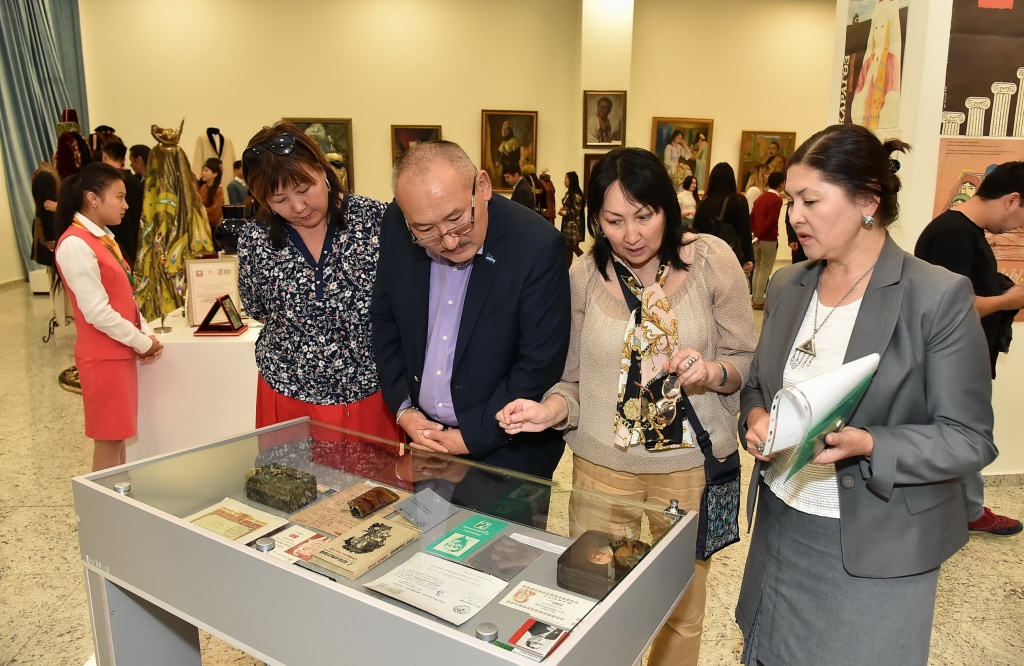
In 2015 (19-23.10) - Grand - Prix for the play "And dreamlife ..." international festival "Art-Orda", Kyrgyzstan. In 2015, (26-31.10) - Grand - Prix for the performance "Sultan Beybars" in international theater festival named after Rakhymzhan Otarbaev, Atyrau. The exposition contains exhibits of the theater Museum, whose history goes back spanning 48 years. A unique collection presented here are connected with the actors and creative life of the itself Drama Theatre: photos, awards, gifts, posters, programs, sketches for performances, personal belongings of famous actors, theatrical costumes, historical portraits of the figures of arts works of famous artists, and more. In the opening ceremony of the jubilee exhibition was attended by Asanali Ashimov - artistic director of the Kazakh State Academic Drama Theater named after Mukhtar Auezov, In his speech, the artistic director of the Kazakh State Academic Drama Theater named after Mukhtar Auezov, People's Artist of the Union of Soviet Social Republics, State Prize Laureate of the Union of Soviet Social Republics and the Republic of Kazakhstan Asanali Ashimov said that they are a particularly respected for actors of the old school, whose portraits and personal items on display at the current exhibition. When they entered the door, they lined up against the wall. So they have shown their respect for him. He noted that each country should have its own culture. Also think that theatre - is a place that educates people. Also it wa said that each exhibit here - priceless. And these personalities of the theater, photos of which public guests will see here are very important goods fo Kazakstan youth. They are - their teachers for life, their spiritual wealth. In the opening ceremony of the jubilee exhibition was also attended by People's Artist of the Union of Soviet Socialist Republics, laureate of State Prize of the Union of Soviet Socialist Republics and the Republic of Kazakhstan, Erlan Bilyalov - Director of the Kazakh State Academic Drama Theater named after Mukhtar Auezov, Honored Worker of Kazakhstan, Laureate of the Union of Youth Award. And in the opening ceremony of the anniversary exhibition also participated Alia Bopezhanova - head of the literary part of the Kazakh State akdemicheskogo Drama Theater named after Mukhtar Auezov, Honored Worker of Kazakhstan, the winner of "Alash" prize, a member of the Academy of Journalism of Kazakhstan. And of course as well as the actors of drama theater and cultural figures of Kazakhstan. Speaking at the opening ceremony, the director of the National Museum Darkhan Mynbay noted special importance for the spirituality of the theater of the Kazakh people with 90 years of history. He noted that today Academic drama Theatre named after Mukhtar Auezov brought a large exhibition. He told that the exhibition is dedicated to the 25th anniversary of Returning Independence and the 90th anniversary of the theater. This exhibition, that audince will have seen not as the history of the theater, as well as the history of Kazakh art and Kazakh intelligentsia in general. Mynbay thinks that the theater, which was opened at the beginning of the twentieth century, to be precise, in 1926 in the city of Kyzylorda, has its own cautionary tale, and the first theatrical performances of the play were "Altyn saqina" and "Enlіk-Kebek.". A few times concluded in the opinion that in this theater work by many famous artists. The theater has gained a lot of experience that will be invaluable heritage for future generations. Therefore, its important to consider a great achievement that the exhibition tells the history of the theater, it opened at the National Museum in Astana, in capital. As we know and Mynbai remains that The National Museum is visited by people from all over the country and the world. Now the museum audience ang guests of capital or country visitors can see an exhibition of the Kazakh theater to get acquainted with its history thinks D.Mynbay. Also he reapeted several times that the exposition contains exhibits of the theater Museum, whose history goes back spinning 48 years. A unique collection presented here are connected with the actors and creative life of the itself Drama Theatre: photos, awards, gifts, posters, programs, sketches for performances, personal belongings of famous actors, theatrical costumes, historical portraits of the figures of arts works of famous artists, and more.
 At the National Museum of the Republic of Kazakstan held the opening ceremony of the exhibition "Milestones of the theater history" of the museum of the Kazak State Academic Drama Theater named after Mukhtar Auezov.
At the National Museum of the Republic of Kazakstan held the opening ceremony of the exhibition "Milestones of the theater history" of the museum of the Kazak State Academic Drama Theater named after Mukhtar Auezov. 

 In 1928 most visited performances were "Lovers", "Perizat and Ramazan" of Tlepbergenov, "Canapiya-Sharbanu" of Jussupbek Aimautov, "The mullahs bribe-takers," of Baiguzhaev, "Nadir Khan" of Narimanov. "Recluse" of Malabaelz, "Marriage" of Gogol (directed by Kozhamkulov and Dzhandarbekov), "Takers" of Koshke Kemengerov, "From death to the hope" directed by himself J. Shanin, "Karakalpak girl" of Ermanov, "Bayan-batyr" directed by himself J. Shanin. In 1929 most liked performances were (After moving to Alma-Ata) "Points" of Beimbet Maylin. "Zaure" of Bayseitov and Shanin (directed by Baiseitov), "Marriage" (directed by Sokolov). In 1930, the most discussed performances were "Bloody stick" of Kamalov and Tair Zharokov, "Bolat" A. Shanin (directed by J. Shanin) "The verdict" of Levitina (directed by Sokolov), "Mine" of J. Shanin (directed by Dzhandarbekov, art director Stolyarov), "Agony" of Temirbekov (directed by himself J. Shanin ), "Fighting" of Bayseitov and A. Shanin (directed by Baiseitov), "Loitering" of Beimbet Maylin. In 1931, the most adored by the public performances were "In the day of judgment" (directed by Jumat Shanin), "Black Heart" of Iliyas Jansugurov (directed by Zhumat Shanin), "Bloody torture" of Baiseitov (directed by Beisov), "Rebellion" of Dmitri Furmanov, "Revenge" of Iliyas Dzhansugurov, "Front" of Beimbet Maylin (directed by Zhumat Shanin, art director Stolyarov), "the Far East", "Yellow devil" (directed by Kurmanbek Dzhandarbekov).
In 1928 most visited performances were "Lovers", "Perizat and Ramazan" of Tlepbergenov, "Canapiya-Sharbanu" of Jussupbek Aimautov, "The mullahs bribe-takers," of Baiguzhaev, "Nadir Khan" of Narimanov. "Recluse" of Malabaelz, "Marriage" of Gogol (directed by Kozhamkulov and Dzhandarbekov), "Takers" of Koshke Kemengerov, "From death to the hope" directed by himself J. Shanin, "Karakalpak girl" of Ermanov, "Bayan-batyr" directed by himself J. Shanin. In 1929 most liked performances were (After moving to Alma-Ata) "Points" of Beimbet Maylin. "Zaure" of Bayseitov and Shanin (directed by Baiseitov), "Marriage" (directed by Sokolov). In 1930, the most discussed performances were "Bloody stick" of Kamalov and Tair Zharokov, "Bolat" A. Shanin (directed by J. Shanin) "The verdict" of Levitina (directed by Sokolov), "Mine" of J. Shanin (directed by Dzhandarbekov, art director Stolyarov), "Agony" of Temirbekov (directed by himself J. Shanin ), "Fighting" of Bayseitov and A. Shanin (directed by Baiseitov), "Loitering" of Beimbet Maylin. In 1931, the most adored by the public performances were "In the day of judgment" (directed by Jumat Shanin), "Black Heart" of Iliyas Jansugurov (directed by Zhumat Shanin), "Bloody torture" of Baiseitov (directed by Beisov), "Rebellion" of Dmitri Furmanov, "Revenge" of Iliyas Dzhansugurov, "Front" of Beimbet Maylin (directed by Zhumat Shanin, art director Stolyarov), "the Far East", "Yellow devil" (directed by Kurmanbek Dzhandarbekov). 1932 remembered by such brilliant play-pieces "The glow" of Gaydovsky (directed by Baiseitov), "Teacher madrassas" of Beimbet Maylin (directed Seraly "Serke" Kozhamkulov), "Homeless" of Shanin (directed by Kalibek Kuanyshpaev), "Turksib" of Iliyas Dzhansugurov, "Submarine" of Trigger (Taneyev, art director Stolyarov), "For October" Mukhtar Auezov (directed by Zhumat Shanin). The performances of the theater differed ethnography, precision in the transmission of national life. During the First Five-Year Plan in the repertoire of the play appeared on the themes of industrialization - "Mine" of Shanin (1930), "Turksib" of Dzhansugurov (1932), on the collectivization - "Revenge" of Dzhansugurov, "Front" of Maylin (both 1931). In 1932-1938 Mukhtar Auezov was head of literary department. In 1933 -34, music studio separated from the theater. In 1936, theatre participated in the ten-day of Kazak literature and art in Moscow. 1933 - 1937 remembered to the public of theater by such brilliant play-piece stages as "Bread" of Kirshon (directed by Nasonov, art director Zverev), "My friend" of Pogodin (directed by Nasonov, art director Ulanovskii), "Mstislav the Bold" of Prut (directed by Nasonov, art director Khodzhikov), "Enlik and Kebek" of Mukhtar Auezov. 1934. "The document" of Rahmankulov (directed by Baiseitov), "Khan Kone" of Mukhtar Auezov (directed by Nasonov, Bekov), "Taltanbay" of Beimbet Maylin (directed by Nasonov, art director Khodzhikov).
1932 remembered by such brilliant play-pieces "The glow" of Gaydovsky (directed by Baiseitov), "Teacher madrassas" of Beimbet Maylin (directed Seraly "Serke" Kozhamkulov), "Homeless" of Shanin (directed by Kalibek Kuanyshpaev), "Turksib" of Iliyas Dzhansugurov, "Submarine" of Trigger (Taneyev, art director Stolyarov), "For October" Mukhtar Auezov (directed by Zhumat Shanin). The performances of the theater differed ethnography, precision in the transmission of national life. During the First Five-Year Plan in the repertoire of the play appeared on the themes of industrialization - "Mine" of Shanin (1930), "Turksib" of Dzhansugurov (1932), on the collectivization - "Revenge" of Dzhansugurov, "Front" of Maylin (both 1931). In 1932-1938 Mukhtar Auezov was head of literary department. In 1933 -34, music studio separated from the theater. In 1936, theatre participated in the ten-day of Kazak literature and art in Moscow. 1933 - 1937 remembered to the public of theater by such brilliant play-piece stages as "Bread" of Kirshon (directed by Nasonov, art director Zverev), "My friend" of Pogodin (directed by Nasonov, art director Ulanovskii), "Mstislav the Bold" of Prut (directed by Nasonov, art director Khodzhikov), "Enlik and Kebek" of Mukhtar Auezov. 1934. "The document" of Rahmankulov (directed by Baiseitov), "Khan Kone" of Mukhtar Auezov (directed by Nasonov, Bekov), "Taltanbay" of Beimbet Maylin (directed by Nasonov, art director Khodzhikov). 
 1935. "Night rumblings" of Mukhtar Auezov (directed by Rutkowski, art director Kantor), "Arkalyk Batyr "of Shanin (directed by Nasonov, Umurzakov, art director Kantor)," Our Dzhigits "of Beimbet Maylin (directed by Kalabukhov)," Two Girls "of Baiseitov (directed by Nasonov)," Stone plumage "of Mukhtar Auezov (directed by Nasonov, art director Nenashev). 1936. "The Aristocrats" of Pogodin (translation of Mukhtar Auezov, directed by Borov, art director Ufimtsev), "Inspector General" (translation of Mukhtar Auezov, dir. Borov, art director Zavarzin), "Red Falcons" of Saken Seifullin (directed by Nasonov, art director Kondoidi). 1937. "Amangeldy" of Gabit Musrepov (directed by Borov), "In an apple orchard" of Mukhtar Auezov (directed by Borov, art director Charnomsky), "Spring Love" (directed by Nasonov). In 1937 to the theatre has been appropriated the status of "Academic". 1937-1946 was remembered to public of the theater by 1938. "Azret Sultan" of Tokmagambetov (directed by Nasonov), "On the border" of Mukhtar Auezov (directed by Nasonov), "Tricks of Rock" (directed by Holodnaya), "Isatai and Makhambet" of Ahinzhanov (directed by Ismailov). 1939. "In the days of struggle" of Sabit Mukanov (directed by Nasonov), "Othello" (translation of Mukhtar Auezov, dir. Sokolovsky, art director Khodzhikov, Uskembaev), "White Birch" of Abdilda Tazhibaev and of Mukhtar Auezov (directed by Nasonov).
1935. "Night rumblings" of Mukhtar Auezov (directed by Rutkowski, art director Kantor), "Arkalyk Batyr "of Shanin (directed by Nasonov, Umurzakov, art director Kantor)," Our Dzhigits "of Beimbet Maylin (directed by Kalabukhov)," Two Girls "of Baiseitov (directed by Nasonov)," Stone plumage "of Mukhtar Auezov (directed by Nasonov, art director Nenashev). 1936. "The Aristocrats" of Pogodin (translation of Mukhtar Auezov, directed by Borov, art director Ufimtsev), "Inspector General" (translation of Mukhtar Auezov, dir. Borov, art director Zavarzin), "Red Falcons" of Saken Seifullin (directed by Nasonov, art director Kondoidi). 1937. "Amangeldy" of Gabit Musrepov (directed by Borov), "In an apple orchard" of Mukhtar Auezov (directed by Borov, art director Charnomsky), "Spring Love" (directed by Nasonov). In 1937 to the theatre has been appropriated the status of "Academic". 1937-1946 was remembered to public of the theater by 1938. "Azret Sultan" of Tokmagambetov (directed by Nasonov), "On the border" of Mukhtar Auezov (directed by Nasonov), "Tricks of Rock" (directed by Holodnaya), "Isatai and Makhambet" of Ahinzhanov (directed by Ismailov). 1939. "In the days of struggle" of Sabit Mukanov (directed by Nasonov), "Othello" (translation of Mukhtar Auezov, dir. Sokolovsky, art director Khodzhikov, Uskembaev), "White Birch" of Abdilda Tazhibaev and of Mukhtar Auezov (directed by Nasonov).